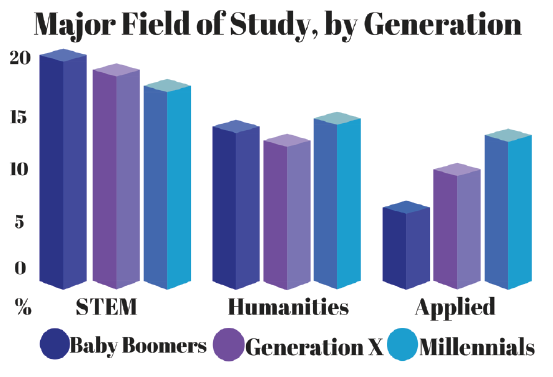
Studies show that both the millennial generation and women in general may have specific outlooks on the participation in fields involved in STEM, otherwise known as science, technology, engineering and mathematics.
According to The 15 Economic Facts on Millennials by The Council of Economic Advisors from October, 2014, millennials are more likely to study social sciences or applied fields. These areas are likely to include communications, criminal justice, and library science, which do not fit into traditional liberal arts curricula but do in fact correspond more directly to specific careers.
How does this relate to current numbers for STEM fields on Cabrini’s campus?
“The number of math majors we’ve gotten has declined a bit in the past couple of years, although since our enrollment is small to start with, I’m not sure if the fewer students is due to declining interest in math or just random fluctuations [but] the number of IST majors we’ve gotten has grown in recent times,” Dr. John Brown, chair and associate professor of mathematics, said.
In fact, Linda Calderin, IST lecturer, believes that the decline of students entering the STEM majors could be attributed to many factors. “Unless we get students interested in these fields at an earlier age, the U.S. will continue to fall behind other countries in the STEM fields,” Calderin said. “There are more employment opportunities in STEM, yet U.S. students are not seeking out these professions.”
“When viewed over successive generations, the evidence suggests that the percent of millennials studying STEM fields is only slightly lower than in past generations,” Dr. David Madway, instructor of mathematics, said in an email. “According to the Council of Economic Advisors and the Digest of Education Statistics: baby boomers- 21 percent; Gen X- 20 percent; millennials- 19 percent.”
Madway also believes that the total number of majors in STEM fields have increased over time as college enrollment has expanded but not as fast as the number of students in other majors.
“There has been a significant increase in the percentage of students studying social science or applied fields like communications and criminal justice,” Madway said. “The U.S. government considers these areas to be career-specific in that they do not fit into the traditional definition of a liberal curriculum. This is an example of higher education responding to market demand – the demand that college prepare students for a career path.”
Another important aspect that is not going unseen is the study of STEM with women in today’s society and the demand for jobs in these fields.
“The AAUW published its report in 2013, and pointed primarily to social and environmental factors. For example, some people consider STEM professions more suitable for men and hold negative opinions of women in ‘masculine’ positions,” Karen Cator, president and CEO of Digital Promise and previously titled the director of the Office of Educational Technology at the U.S. Department of Education, said in an online published www.linkedin.com post. “There are few female professors in STEM fields to serve as role models [and] there is unconscious as well as conscious bias against women in STEM.”
Madway also believes that the landscape has changed dramatically for women. “As the baby boomers came of age, women became a cultural and economic catalyst for change.”
“Women earn 57 percent of bachelor’s degrees and 63 percent of master’s degrees awarded in America,” said Cator. “However, we receive just 31 percent of degrees in science, technology, engineering and math (STEM), including just 19 percent of engineering degrees and 18 percent of computer science degrees. Although we represent nearly half of the U.S. workforce, we hold just 25 percent of STEM jobs.”
Madway also believes that Title IX in 1972 was a “culminating event in response to a civil rights movement that included race and gender political empowerment.” Here, traditional attitudes changed and opportunities expanded while “business degrees have become more popular among women over the same period, increasing from nine percent of the class of 1970 to 16 percent of the class of 2011, after peaking in the mid-1980s for both men and women.”
“Compared to most fields such as business, law, and medicine, the STEM professions are culturally and socially non-progressive,” Madway said. “As a result, pernicious rigid gender stereotypes are pervasive in the STEM professions. Prospects for marginalization and discrimination in the workplace provide a disincentive for women to choose a STEM major in college.”
Calderin thinks that one way in which society can change this issue for the better is by increasing the number of high school STEM academies. One school in particular in the Downingtown, Pennsylvania school district has opened a STEM high school and has been ranked as the top school in Pennsylvania for the past two years.
Both Brown and Calderin agree that they would like to see a positive change on these issues.
“If in fact interest in STEM areas has declined, that’s a concern since many companies are highly reliant on people who have mathematical, scientific and technology skills,” Brown said. “I hope it’s just part of a cycle that will turn the other way soon.”
“I’d like to see our universities offer more scholarship funds to students entering the STEM fields,” Calderin said. “At a recent high school graduation I attended, every female that was entering an engineering program did receive scholarship money so there is hope.”


